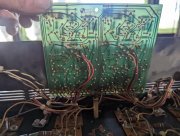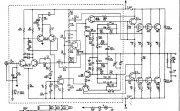MusicSteve
Journeyman
No should be the same, I would questline it (but it might work) and one is NPN and the other is PNPOk just had another look at it, for info left channel is putting out DC.
Left channel
Q8 marked 2n1304
Q9 marked 2n1305
Right channel
Q8 marked 2n1308
Q9 marked 2n1307
Does this sound right?
Also there is a resistor in parallel to d8 on both channels
Left is 3.8k and right is 1.5k.
Right channel also has no heatsinks on q7 and q10.
Everything else looks factory or has been done by someone proficient with an iron.
Board is a 14b.
Also there is a resistor in parallel to d8 on both channels
Left is 3.8k and right is 1.5k.
No, this is part of the bias (I would check the each diode D6,D7,D8 and all together note- if I have the correct drawing (never had this board,,,,, Gene do you have a schematic of this board, mine is not to clear)
Do you have a Pic of the back of the control Board?
if you can , Try to find out wear the heat is generating at? (Infrared Laser Thermometer)
Good luck



